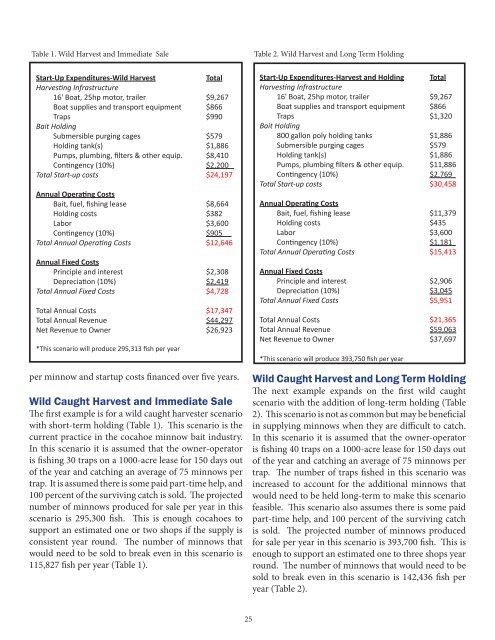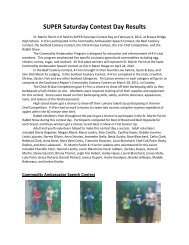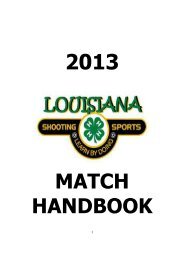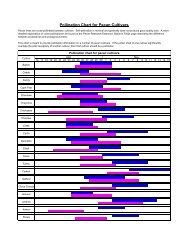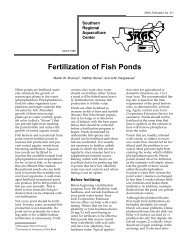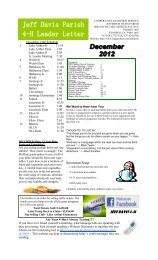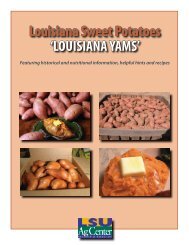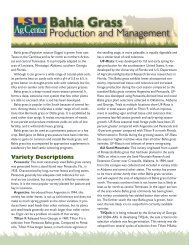Cocahoe Minnow - The LSU AgCenter
Cocahoe Minnow - The LSU AgCenter
Cocahoe Minnow - The LSU AgCenter
Create successful ePaper yourself
Turn your PDF publications into a flip-book with our unique Google optimized e-Paper software.
Table 1. Wild Harvest and Immediate Sale<br />
Start-Up Expenditures-Wild Harvest Total<br />
Harvesting Infrastructure<br />
16' Boat, 25hp motor, trailer $9,267<br />
Boat supplies and transport equipment $866<br />
Traps $990<br />
Bait Holding<br />
Submersible purging cages $579<br />
Holding tank(s) $1,886<br />
Pumps, plumbing, filters & other equip. $8,410<br />
Contingency (10%) $2,200<br />
Total Start-up costs $24,197<br />
Annual Operating Costs<br />
Bait, fuel, fishing lease $8,664<br />
Holding costs $382<br />
Labor $3,600<br />
Contingency (10%) $905<br />
Total Annual Operating Costs $12,646<br />
Annual Fixed Costs<br />
Principle and interest $2,308<br />
Depreciation (10%) $2,419<br />
Total Annual Fixed Costs $4,728<br />
Total Annual Costs $17,347<br />
Total Annual Revenue $44,297<br />
Net Revenue to Owner $26,923<br />
*This scenario will produce 295,313 fish per year<br />
per minnow and startup costs financed over five years.<br />
Wild Caught Harvest and Immediate Sale<br />
<strong>The</strong> first example is for a wild caught harvester scenario<br />
with short-term holding (Table 1). This scenario is the<br />
current practice in the cocahoe minnow bait industry.<br />
In this scenario it is assumed that the owner-operator<br />
is fishing 30 traps on a 1000-acre lease for 150 days out<br />
of the year and catching an average of 75 minnows per<br />
trap. It is assumed there is some paid part-time help, and<br />
100 percent of the surviving catch is sold. <strong>The</strong> projected<br />
number of minnows produced for sale per year in this<br />
scenario is 295,300 fish. This is enough cocahoes to<br />
support an estimated one or two shops if the supply is<br />
consistent year round. <strong>The</strong> number of minnows that<br />
would need to be sold to break even in this scenario is<br />
115,827 fish per year (Table 1).<br />
25<br />
Table 2. Wild Harvest and Long Term Holding<br />
Start-Up Expenditures-Harvest and Holding Total<br />
Harvesting Infrastructure<br />
16' Boat, 25hp motor, trailer $9,267<br />
Boat supplies and transport equipment $866<br />
Traps $1,320<br />
Bait Holding<br />
800 gallon poly holding tanks $1,886<br />
Submersible purging cages $579<br />
Holding tank(s) $1,886<br />
Pumps, plumbing filters & other equip. $11,886<br />
Contingency (10%) $2,769<br />
Total Start-up costs $30,458<br />
Annual Operating Costs<br />
Bait, fuel, fishing lease $11,379<br />
Holding costs $435<br />
Labor $3,600<br />
Contingency (10%) $1,181<br />
Total Annual Operating Costs $15,413<br />
Annual Fixed Costs<br />
Principle and interest $2,906<br />
Depreciation (10%) $3,045<br />
Total Annual Fixed Costs $5,951<br />
Total Annual Costs $21,365<br />
Total Annual Revenue $59,063<br />
Net Revenue to Owner $37,697<br />
*This scenario will produce 393,750 fish per year<br />
Wild Caught Harvest and Long Term Holding<br />
<strong>The</strong> next example expands on the first wild caught<br />
scenario with the addition of long-term holding (Table<br />
2). This scenario is not as common but may be beneficial<br />
in supplying minnows when they are difficult to catch.<br />
In this scenario it is assumed that the owner-operator<br />
is fishing 40 traps on a 1000-acre lease for 150 days out<br />
of the year and catching an average of 75 minnows per<br />
trap. <strong>The</strong> number of traps fished in this scenario was<br />
increased to account for the additional minnows that<br />
would need to be held long-term to make this scenario<br />
feasible. This scenario also assumes there is some paid<br />
part-time help, and 100 percent of the surviving catch<br />
is sold. <strong>The</strong> projected number of minnows produced<br />
for sale per year in this scenario is 393,700 fish. This is<br />
enough to support an estimated one to three shops year<br />
round. <strong>The</strong> number of minnows that would need to be<br />
sold to break even in this scenario is 142,436 fish per<br />
year (Table 2).


